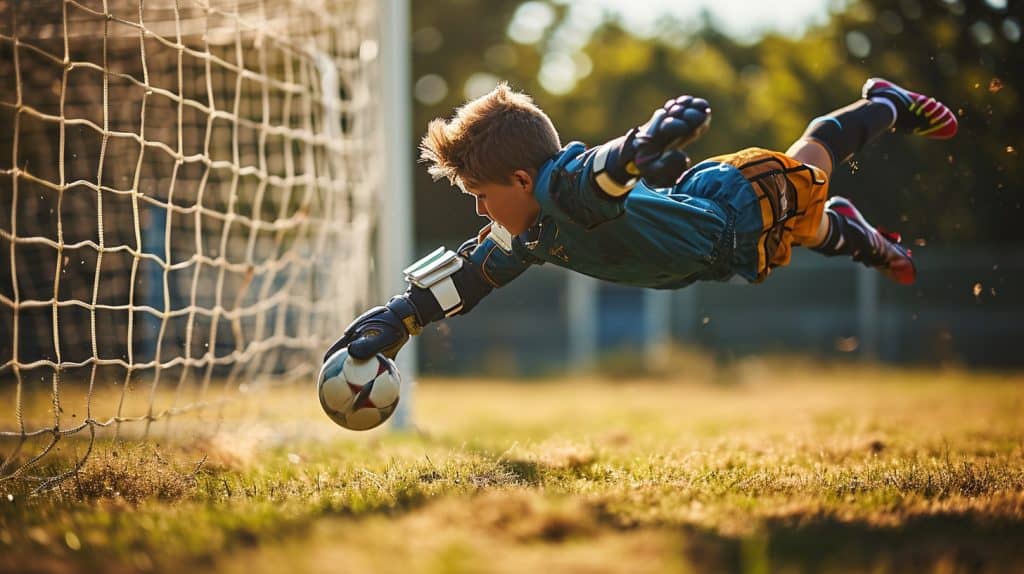Essential Exercises for Goalkeepers: Training Drills and Meal Plans
Introduction
Elevating Your Game with Specialized Goalkeeper Training
In the dynamic world of soccer, the role of a goalkeeper is both critical and unique. Specialized training for goalkeepers is essential for honing skills that are distinct from outfield players. Goalkeeper training focuses on developing agility, strength, reflexes, and strategic thinking. This comprehensive guide delves into various goalkeeper-specific exercises designed to enhance these attributes. From mastering dives to refining reaction times and building fitness, we cover essential drills that every aspiring soccer goalkeeper needs to integrate into their training regime. On Day 16, we went over how to prepare for your soccer match. Today, we will provide a guide to a goalkeeper’s day from sunrise to sunset, featuring meals and drills to keep you at the top of your game.
Dives: Mastering the Art of Goalkeeping
Essential Techniques for Game-Like Saves
Description and Benefits: Dives are a fundamental aspect of goalkeeping, crucial for making those game-saving stops. Practicing dives correctly improves not just your ability to reach the ball, but also your landing technique, which is vital for injury prevention.
Step-by-Step Guidance:
- Setup:
- Place a line of cones on the ground, spaced evenly apart.
- The cones act as markers to dive over, simulating the act of reaching for the ball in a game.
- Execution:
- Stand next to a cone, ready to dive.
- Push off with your legs, aiming to dive over the cone and land safely on the other side.
- Use your arms to guide your motion and protect your body as you land.
- Practice diving in both directions, ensuring you’re comfortable diving to your left and right.
- Focus on extending your reach while maintaining control and balance.
- Gradually increase the height of the cones or the distance you dive as your confidence and technique improve.
By regularly practicing dives, goalkeepers can significantly enhance their ability to make crucial saves during matches.
Enhancing Reflexes with Reaction Balls
Quick Response Training for Goalkeepers
Description and Benefits: Utilizing reaction balls in training significantly improves a goalkeeper’s hand-eye coordination and reflexes. These irregularly shaped balls bounce unpredictably, mimicking the unexpected nature of shots faced in a match. Training with reaction balls is key to developing quick, instinctive responses necessary for high-level goalkeeping.
Step-by-Step Guidance:
- Setup:
- Choose an open space with a flat surface.
- Have a reaction ball ready – these are special balls designed to bounce unpredictably.
- Execution:
- Throw the reaction ball against a wall or on the ground.
- Prepare to catch or block the ball as it bounces back in an unpredictable manner.
- Focus on maintaining a ready stance, with hands prepared and eyes on the ball.
- Work on quick adjustments in position to respond to the ball’s erratic movements.
- Practice this drill regularly, increasing the intensity and speed as your reflexes improve.
Incorporating reaction ball exercises into your training routine sharpens your ability to anticipate and react, crucial for those split-second decisions in goal.
Building Explosive Power with Plyometric Jumps
Enhancing Goalkeeping Athleticism
Description and Benefits: Plyometric jumps are integral in building a goalkeeper’s explosive power. This type of training strengthens the legs for powerful jumps and dives, essential for reaching high shots and making rapid movements across the goal.
Step-by-Step Guidance:
- Setup:
- Use a sturdy box or platform suitable for jumps.
- Ensure the height is challenging yet safe for jumping.
- Execution:
- Stand in front of the box with feet shoulder-width apart.
- Perform a squat, then explosively jump onto the box.
- Land softly with your knees slightly bent to absorb the impact.
- Step back down and repeat the jump.
- Focus on explosive upward movements and controlled landings.
- Incorporate various types of jumps, such as single-leg jumps, to enhance overall leg strength and stability.
Regular practice of plyometric jumps not only increases a goalkeeper’s reach but also improves overall agility and quickness in the goal area.
Quick Feet: Ladder Drills for Improved Footwork
Boosting Agility and Coordination
Description and Benefits: Ladder drills are an excellent way for goalkeepers to enhance their footwork, agility, and coordination. These exercises involve quick, precise foot movements through a ladder laid on the ground, mirroring the rapid footwork required in goalkeeping during matches.
Step-by-Step Guidance:
- Setup:
- Lay a training ladder flat on the ground in an open space.
- Stand at the end of the ladder, ready to move.
- Execution:
- Perform various drills, such as two-footed hops into each box, lateral shuffles, or in-and-out steps.
- Focus on quick, light foot touches, maintaining speed and accuracy as you move through the ladder.
- Keep your body over your feet, maintaining balance and control.
- Gradually increase your speed as you become more comfortable with the movements.
- Repeat these drills, aiming for fluidity and precision in your footwork.
Practicing ladder drills regularly greatly improves a goalkeeper’s ability to move quickly and efficiently, essential for successful goalkeeping.
Upper Body Strength: Medicine Ball Throws
Developing Power for Enhanced Performance
Description and Benefits: Strong upper body strength is crucial for goalkeepers, particularly for throwing and deflecting shots. Medicine ball throws are an effective way to develop this strength, focusing on the arms, chest, and shoulders.
Step-by-Step Guidance:
- Setup:
- Choose a medicine ball of suitable weight – heavy enough to challenge but not so heavy as to strain.
- Stand in an open area with enough space for throwing the ball.
- Execution:
- Perform various throws, such as overhead throws, chest passes, and rotational throws.
- Focus on engaging your core and using your entire upper body to generate power.
- Catch the ball on the rebound or have a partner throw it back to you.
- Maintain a balanced stance, ensuring your movements are controlled and powerful.
- Repeat these exercises, varying the types of throws to work different muscle groups.
Integrating medicine ball throws into training routines enhances a goalkeeper’s ability to powerfully and accurately distribute the ball, as well as effectively block shots. Goalkeeper fitness is often overlooked, but this type of drill will help set you apart.
Agility Runs for Quick Directional Changes
Enhancing Speed and Flexibility in Movement
Description and Benefits: Agility runs are critical for goalkeepers to develop the ability to change direction quickly and efficiently. Setting up a slalom course simulates the rapid, unpredictable movements needed during a game, improving a goalkeeper’s overall agility and reaction time.
Step-by-Step Guidance:
- Setup:
- Arrange a series of cones in a zigzag pattern to create a slalom course.
- Position the cones at a challenging yet manageable distance apart.
- Execution:
- Begin at the start of the course and run through the cones as quickly as possible.
- Focus on making quick, sharp turns around each cone while maintaining control and balance.
- Keep your head up and be aware of your surroundings, as in a game scenario.
- Work on your running technique, using short, rapid steps for better agility.
- Repeat the course, trying to improve your time with each run.
Regular practice of agility runs significantly enhances a goalkeeper’s ability to maneuver quickly in goal, crucial for responding to fast-paced game situations.
Vertical Leaps: Training for High Catches
Maximizing Reach and Reaction in the Air
Description and Benefits: Vertical leaps are essential for goalkeepers to effectively reach high shots and crosses. Training to improve vertical leap ability not only aids in making high catches but also in enhancing overall explosive power and reaction speed.
Step-by-Step Guidance:
- Setup:
- Find a space with enough room to jump safely.
- Optionally, use a wall or a tall object to measure your jump height.
- Execution:
- Start from a standing position, then bend your knees and leap upwards as high as possible.
- Use your arms to propel your body upward, aiming to tap or catch a ball held high.
- Focus on a soft landing, with your knees bent to absorb the impact.
- Repeat the jumps, each time trying to reach a little higher.
- As you improve, incorporate movements that mimic catching or deflecting a ball while in the air.
Vertical leap training not only improves a goalkeeper’s ability to contend with high balls but also builds overall leg strength and coordination.
Ball Distribution: Work on Throwing Accuracy and Distance
Perfecting Goalkeeper Throws for Strategic Play
Description and Benefits: Effective ball distribution is a key skill for goalkeepers, impacting the team’s ability to transition from defense to attack. Working on throwing accuracy and distance is crucial for developing this skill, enabling goalkeepers to initiate counter-attacks and distribute the ball accurately to teammates.
Step-by-Step Guidance:
- Setup:
- Choose an open field with marked distances or specific target areas.
- Have a range of soccer balls available for varied throwing practice.
- Execution:
- Practice different types of throws, such as overarm throws, sidearm throws, and bowl throws.
- Aim at specific targets or areas to improve accuracy.
- Work on throwing over various distances, focusing on both power and precision.
- Incorporate movement before the throw, simulating game-like scenarios.
- Regularly change your target areas and distances to challenge and improve your skills.
Consistently practicing accurate and powerful throws ensures a goalkeeper can effectively contribute to the team’s offensive strategy.
Check Out Our Full Free 21 Day Training Program
- Day 1 - Soccer Warmups
- Day 2 - How To Improve Stamina For Soccer
- Day 3 - Soccer Agility Drills
- Day 4 - Soccer Strength Training
- Day 5 - Soccer Dribbling Drills
- Day 6 - Hydration and Rest for Soccer
- Day 7 - How to Gain Confidence in Soccer
- Day 8 - Soccer Endurance Training
- Day 9 - Soccer Speed Training
- Day 10 - Soccer Passing Drills
- Day 11 - Soccer Stretches
- Day 12 - Soccer Defensive Drills
- Day 13 - Soccer Offensive Tips
- Day 14 - Soccer Teamwork
- Day 15 - Soccer Recovery Session
- Day 16 - Preparing for Todays Soccer Match
- Day 17 - Goalkeeper Training
- Day 18 - Ball Handling Drills
- Day 19 - The 3 4 3 Soccer Formation
- Day 20 - Soccer Tactics Training
- Day 21 - How To Get Better At Soccer
What to Read Next
No related articles.

